The Washington Naval Treaty of 1922 brought about major changes in the design of the battleship, most notably cancelling most of the ships being built in American and Japanese yards. In the United States, three classes were affected. I've previously discussed the Colorado and Lexington classes, but a third class, the South Dakotas, were cancelled entirely.
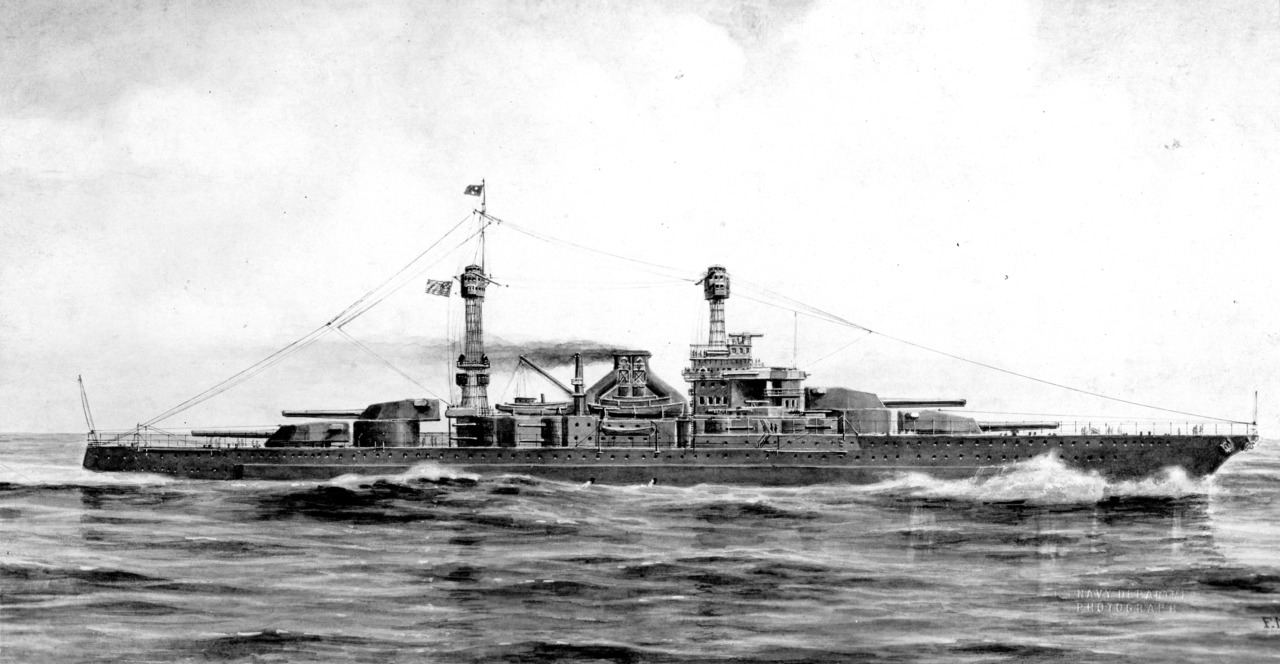
The South Dakota class as designed
The South Dakotas were ordered under the massive Naval Act of 1916, a result of Woodrow Wilson's swing towards naval expansion as the World War dragged on. Americans feared that a victorious power would turn its eyes across the Atlantic, seeking economic dominion over the United States. A fleet "second to none" would be vital to safeguarding US interests from a power with millions of battle-hardened veterans and a war indemnity from the loser. It was not apparent at the time the economic toll that the war would take on the participants, rendering any such dreams moot by 1918. The bill, on the floor of Congress when news arrived of Jutland, authorized ten battleships and six battlecruisers. While the first four were to be derivatives of the existing Tennessee class, which ultimately became the Colorados, the last six could be significantly larger, the ships the USN had been asking for since 1914.
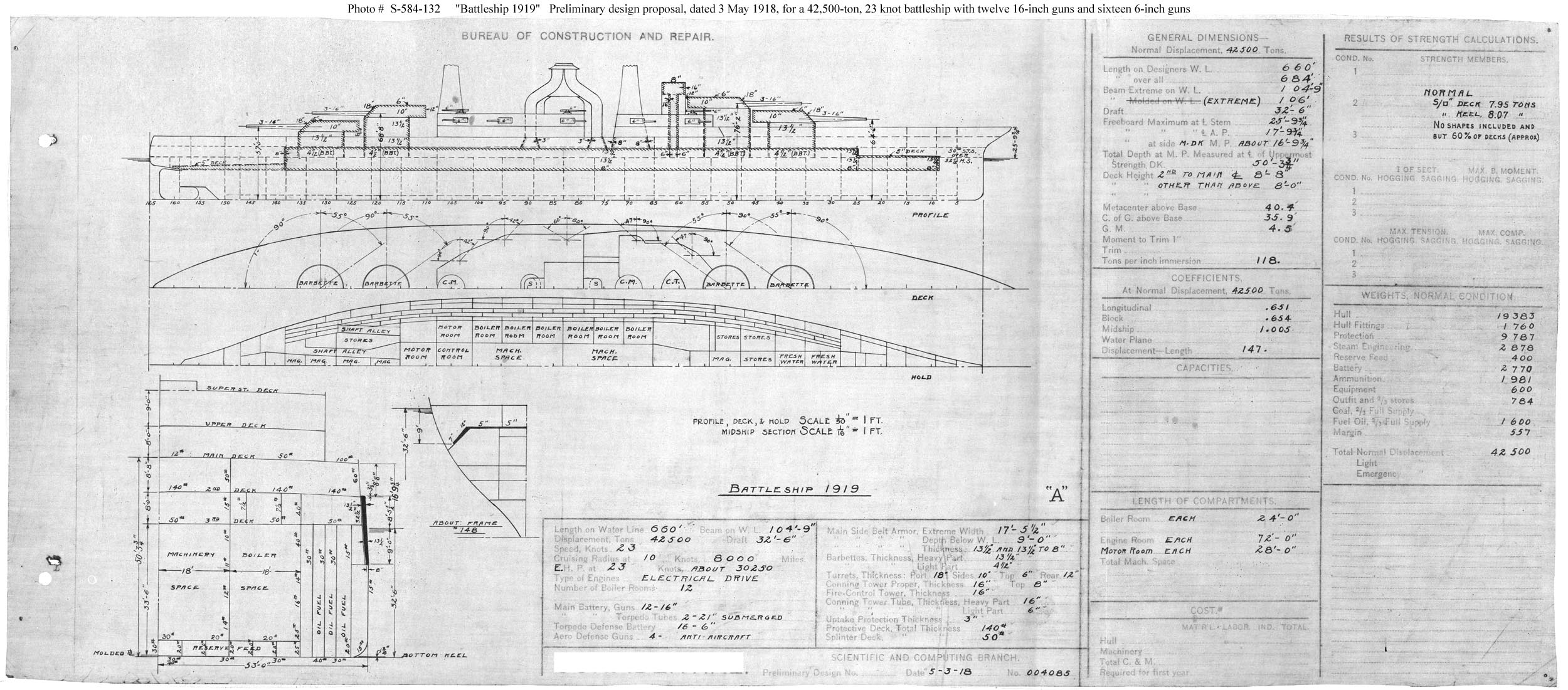
The preliminary design of the South Daktoa
Developments in battleships in Japan and Britain, particularly reports of the British 18" gun project, meant that the General Board, responsible for US ship characteristics, wanted a bigger and more powerful vessel. There was also an upward trend in battleship speed, so the initial characteristics were for a ship with 12 16" guns and a speed of 23 kts. Initial sketches with 6 twin turrets were soon discarded after successful firing trials with the triple turrets on the early Standards, and a new 16"/50 gun was developed to replace the 16"/45 used on the Colorados.1
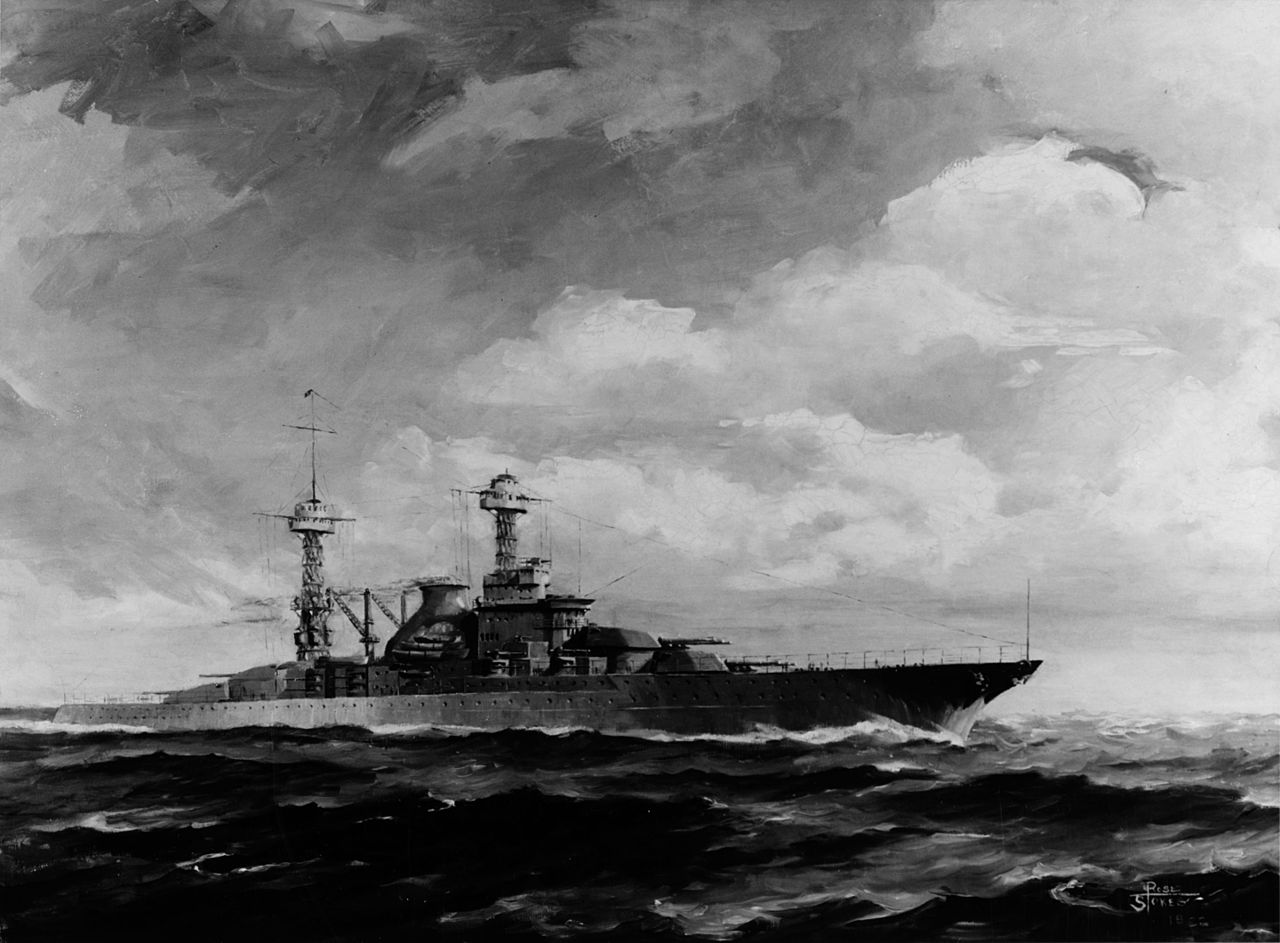
A few sketches were done with improved armor, but the resulting increase in the size of the ship meant that they were also discarded, except for an extra .5" on the armored deck. Secondary armament layout was a more difficult issue, due to the great length of the machinery spaces. One alternative was a twin 5" mount in a blast-proof gunhouse, although this was not adopted for unclear reasons. Another was to concentrate the guns high in the ship for best effectiveness, instead of having them low down as in previous designs. The downside was that blast high in the ship might affect the conning tower. The designers came up with an ingenious solution. The barbette of Turret 2 was made wider, and the ship and fire control spaces were built around the turret structure. This solution, while very clever, was not popular with line officers, who quite reasonably pointed out that a low ship control position was less than ideal, and that a 16" turret going off overhead was likely to be a distraction from commanding the ship. Eventually, the problem was solved by trunking together the various uptakes from the boilers into a single funnel amidships, freeing enough space for the secondary guns.
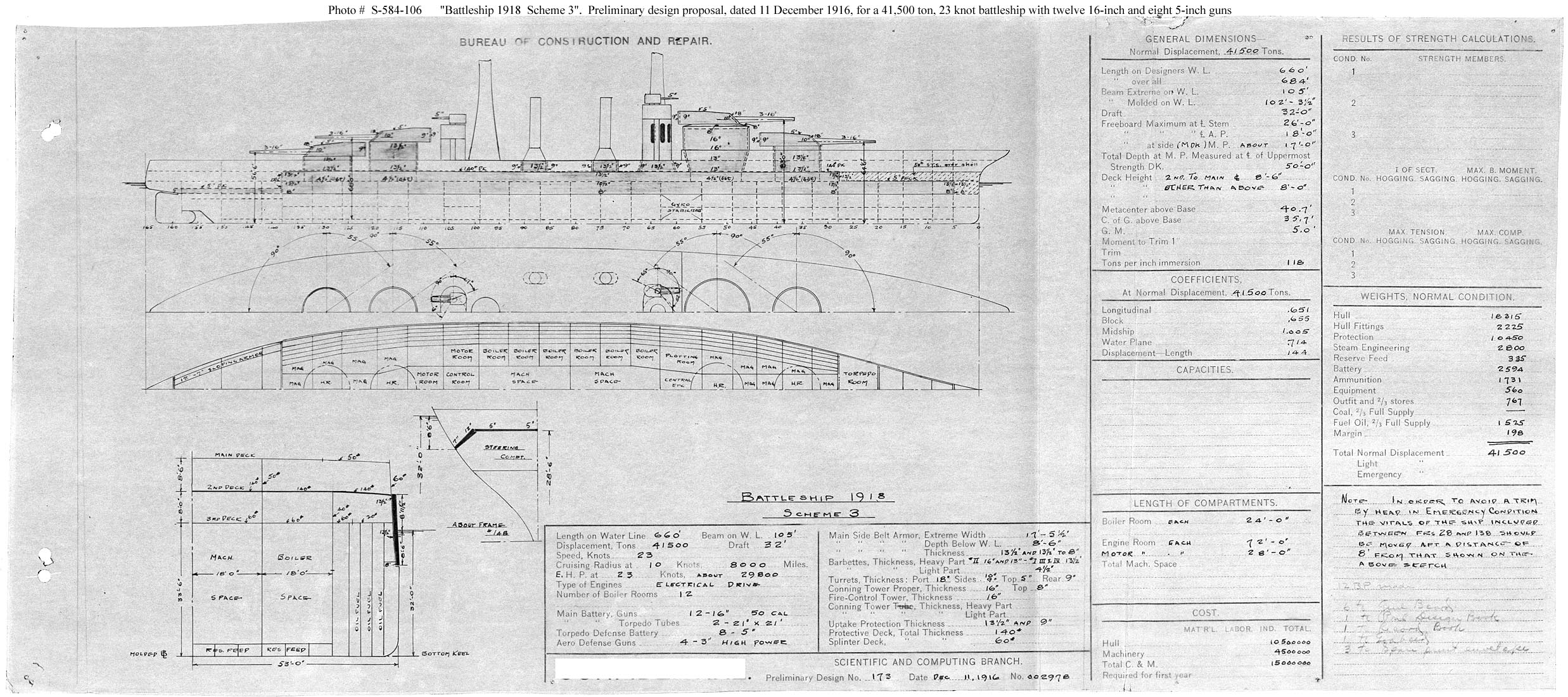
The sketch design with the conning tower integrated into Number 2 barbette
The first three ships built to this design were to have been laid down in late 1917. However, a few months after its entry into the war, the US suspended battleship construction to focus instead on vessels relevant to winning the tonnage war with the U-boats: destroyers, merchant ships, and the like. This resulted in more tweaks to the design, most notably replacing the 5"/51 guns with 6"/53s and making the turret tops thicker. More elaborate plans, most notably involving the use of sloped armor belts, were considered and discarded. The final result was a ship of 43,200 tons, a full 10,000 tons more than the Colorados, 684' long and very powerful, if a bit slow. Six ships were finally laid down in 1920 and 1921, suspended in February 1922, when the Washington Naval Treaty was being negotiated, and scrapped six months later. Five of the six names were reused for fast battleships during WWII, including the greatest vessel ever built. The sixth, Montana, was to be the lead ship of the follow-on class to the Iowas, but they also fell victim to cuts.
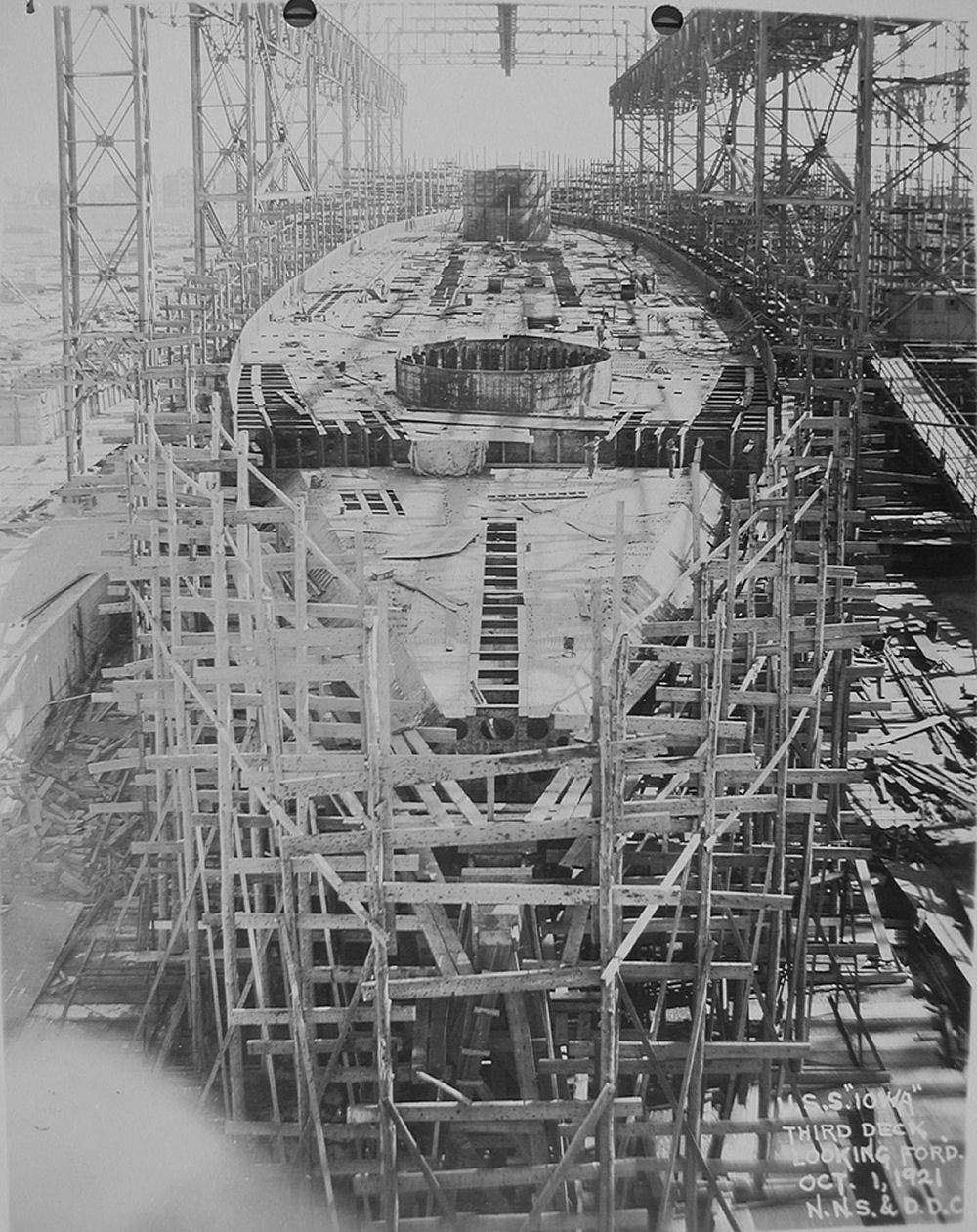
USS Iowa (BB-53) under construction
The South Dakotas were the last in a very successful line of American battleships. New designs for the next class of battleship were in work when the Treaty came into force, mostly focused on improved protection. This would have required several thousand more tons of displacement, and the existing design was already pushing the limits of American docking facilities. As it was, it would be a decade and a half before another American battleship was laid down.
1 After the South Dakotas were cancelled, these guns went into storage. It was originally intended to use them aboard the Iowas, but this plan ran afoul of one of the worst cases of failure to maintain interface documentation in naval history. ⇑

Comments
Since we have been so conditioned by WWII to see the British as natural allies, things like the Naval Act of 1916 and War Plan Red come as kind of a shock, that in the early 20th century there was just as much concern that we might end up fighting the British as anyone else.
On that note, a post on the color-coded plans might be an idea if you are interested. I for one would love to know some of the details, if the information is available.
It is a bit weird. The typical US history view of the British is rather confused. They're usually the good guys, except for a random attack of evil from about 1700 to about 1820, for unexplained reasons. But yes, sometimes I have to remind myself that there was serious antagonism between us until about 1930.
That's a good idea. I'll add it to my list of potential topics.
Wow, War Plan Red is jarring to see. I have enough trouble remembering that US/UK friendship wasn't a sure thing before WWI.
Keep in mind that it is the nature of military organizations to plan for things. I'm sure that there's a plan for war with Canada and/or the UK somewhere in the bowels of the Pentagon today. Both of those nations have similar plans. SAC is reputed to have had plans to bomb American cities, but I'm not entirely sure why or if it's true. War Plan Red was put together because at one point, Britain was the only major opponent possible besides Japan.
In addition to the off-chance we might need one of those unlikely plans, it seems like a good way for your planners to practice their job. Put the junior planners to work figuring out how to invade Canada, compare their work to the last five times you planned it, and you've got a good low-stakes method to train your planning department. Maybe you can use it to distinguish between people you want to keep around and people who would do better switching to a different role.
Heck, if you plan the invasion of a close enough ally, they might be willing to straight-up grade your work for you - arguably this is what a war game is, right?
You're very much not wrong on that. The biggest drawback of using allies as training targets is that the public might not understand what was going on if the plan leaks. That's the stated rationale behind the famous Zombie Plan. It's actually pretty readable, and gives a good idea of how military plans work, as well as having some really funny bits. (I think my favorite is the suggestion that the Chaplain Corps be brought in to counter Evil Magic Zombies.)
An interesting point. Usually, that's not how that works, because everything is joint these days.
The South Dakota sure has a lot of portholes.
One of the advantages of all-or-nothing armor, I guess.